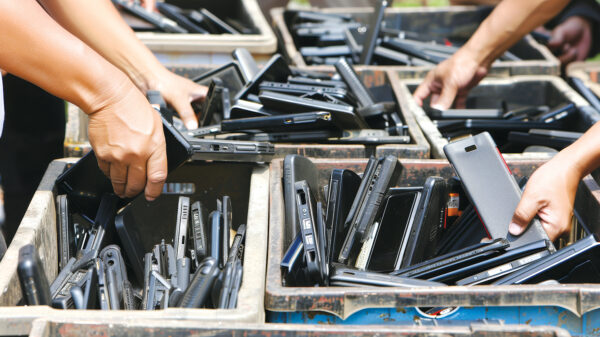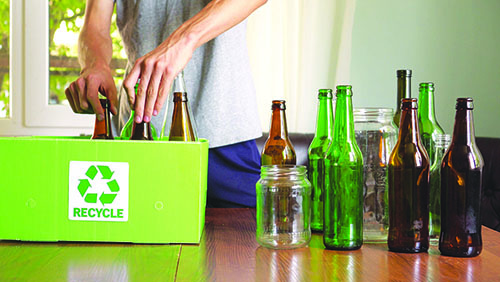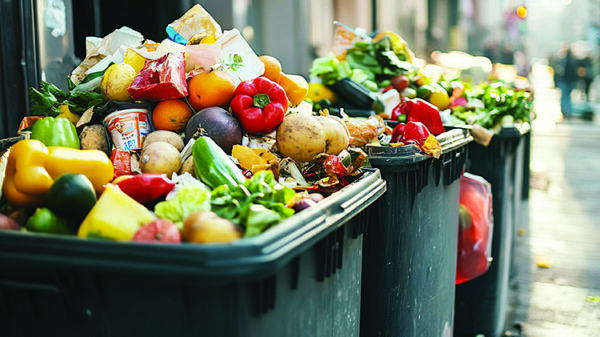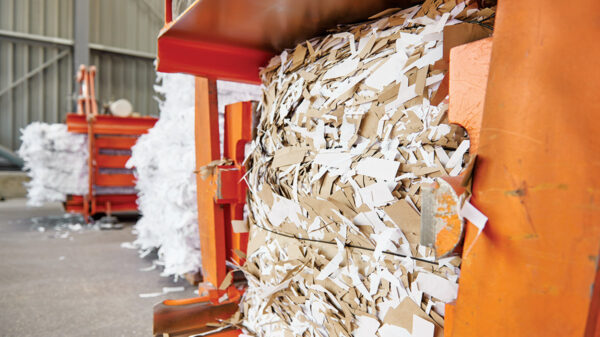The paper recycling industry and the initiatives guiding this industry have significantly evolved in recent years. According to Justine Reichman, founder and chief executive officer of NextGen Purpose, over the past 10 to 20 years, the paper-based recycling industry has evolved and most of that is due to both technological innovation and growing environmental awareness.
“There has been major improvements in how materials are processed – from advancements in ink removal and water usage to the adoption of technologies like infrared sorting,” Reichman said. “These innovations have helped reduce energy consumption and water waste, making the recycling process more efficient and environmentally friendly.”
Reichman also said that one big change in the paper recycling industry is the rise in e-commerce, which has led to an explosion in packaging materials.
“With many stores no longer holding traditional inventory, more items are shipped directly to consumers, creating a larger volume of paper and cardboard entering the recycling stream,” Reichman said. “That puts pressure on the system to be more effective and accountable.”
From what Reichman is seeing, the paper recycling industry is increasingly shifting from composite packaging to more paper-based alternatives, and this is a positive move. Composite packaging has long posed a challenge because it’s made of mixed materials that are difficult and costly to separate and recycle. In contrast, paper based packaging, when designed properly, is more easily recyclable, requires less energy and water to process, and is more compatible with existing municipal recycling systems.
“It’s possible that this change is being driven by a combination of consumer demand for more sustainable options, regulatory pressure and technological innovation, but also as companies work to reduce their carbon footprints and packaging waste, many are turning to fiber-based solutions that align better with circular economy principles,” Reichman said.
Daniel Brindis, impact director at Canopy, said that the reality is clear: Without scaling up recycled paper use, we will overshoot our planet’s ecological limits.
“Long before ‘circularity’ became mainstream, paper recycling was quietly leading the way, showing what a functional, circular system can look like on the ground,” Brindis said.
Canopy works with over 1,000 brand, producer and innovation partners globally, and their message is consistent – recycled paper remains a superior material choice when it comes to climate, water, biodiversity and supply chain resilience.
As Brindis explained, Multiple Life Cycle Assessments (LCAs) continue to confirm that recycled paper significantly reduces greenhouse gas emissions, offering companies a straightforward, credible way to cut their scope-3 emissions. With demand for sustainable materials accelerating, recycled paper is in the right place at the right time.
“At Canopy, we consistently tell our network of brand partners that one of the most impactful moves they can make is to prioritize post-consumer recycled packaging. It’s a win for forests, climate and their business,” Brindis said. “But to meet this growing demand, we need to dramatically improve recycling rates and collection systems.”
Multi-material packaging is on the rise, particularly in consumer goods sectors such as food and beverage packaging. But as Brindis pointed out, without innovation and investment, paper-based composites (e.g., paper with a plastic or aluminum barrier) can pose problems in the recycling stream, which means they can become a dead-end for fiber: once they enter the waste stream, the valuable wood fiber they contain is often lost, forced out of the recycling loop.
“While they may seem like an upgrade over plastic, the reality is that many paper-based composite materials have dismally low actual recycling rates,” Brindis said.
According to Gaspard Duthilleul, chief operating officer at Greyparrot, a change in material for packaging, to something like paper can have unintended consequences, and some good ideas may result in less sustainable outcomes.
“For instance, data from the 55 global recycling waste facilities where Greyparrot analyzers are installed found that waste fiber, such as paper and cardboard, is actually the most common material found in residue lines, meaning it is often heading to the landfill or incinerator and not being recycled,” Duthilleul said.
Making the right decision on sustainable packaging can be complex, given the many factors involved. That’s why Duthilleul said that ultimately, the best approach needs to be based on data, including life cycle analysis with a proper understanding of packaging end-of-life, depending on the market where it is sold.
“For instance, a small wrapper has a very high likelihood of not being sorted and recycled independently,” Duthilleul said. “Therefore, shifting from plastic-based packaging to paper packaging will likely be more sustainable and environmentally friendly. That doesn’t mean it has a higher chance of being recycled – it simply means that if it ends up in a landfill, incinerator, or a natural environment, it will cause less pollution.”
For packaging that is difficult to recycle due to its complexity, such as an old Pringles can, Duthilleul has seen that switching to a high-paper mix, even if a thin layer of polymer remains, can mean these packages are accepted into fiber recycling streams, which increases their recycling rate.
“In other cases, the paperization of packaging might not always be a justified shift. PET bottles and aluminum cans, for example, are sorted very well and have very high recycling rates,” Duthilleul said. “We counted six billion PET bottles moving through recycling facilities in 2024, and despite being the highest volume material, it didn’t rank in the top three for material not being sorted or being found within residue lines. Comparatively, a common coffee cup – which uses paperboard as its primary material – appears more frequently in residue lines.”
“Moving to paper packaging may decrease its sortability, especially if it is multilayered and contains some polymers or metalized elements,” Duthilleul said. “In some cases, regulation could also penalize these packaging types because they’re not mono-material or because it is found that a metalized layer on fiber packaging hinders the
sorting process, for example.”
Embracing Challenges
So what are the biggest challenges facing the paper recycling industry today, especially paper packaging?
The reliable feedstocks of yesterday – newspaper and office paper – are no longer flowing through the system as they once did. According to Brindis, single-stream recycling, while convenient, has driven actual recovery rates down to as low as 38 percent in some regions. Meanwhile, companies eager to replace plastic with paper often create complex composites or add coatings that make paper products harder to recover – removing even more material from the recycling loop.
“For the recycling sector, this is both a challenge and an opportunity,” Brindis said. “We need greater collaboration between brands, recyclers, and policymakers to rethink packaging design, improve recovery systems, and drive scalable solutions. If we get this right, we can dramatically reduce emissions, keep vital forests standing, and strengthen the circular economy – delivering environmental and economic wins across the board.”
Reichman added that when it comes to paper packaging, one of the biggest challenges today is the lack of standardization and consistency across regions. There’s no universal system for recycling, and every town, city or municipality often has its own rules and infrastructure.
“This creates confusion for both consumers and businesses about what can actually be recycled and how to do it properly,” Reichman said.
She added that the challenges facing the paper recycling industry, particularly the lack of standardization, infrastructure, and transparency, pose real obstacles for environmentalists, businesses, and policymakers striving to create meaningful change. When every city or municipality has its own recycling rules, it creates confusion and inconsistency.
“This disconnect undermines public trust and makes it harder for people to act with confidence. If we want to see lasting impact, we need stronger collaboration between public and private sectors, more transparent supply chains, and investment in modern recycling infrastructure,” Reichman said. “Without systemic change, even the most well-intentioned environmental efforts will continue to be limited by the inefficiencies and inconsistencies of the current recycling landscape.”
Reichman said that there have already been so many shifts and changes, but she expects to see more investment in technology that will make paper recycling cleaner and more efficient.
“We can also hope that brands will be pushed to design packaging with recyclability in mind from the very beginning, avoiding unnecessary coatings and mixed materials that complicate the process,” Reichman said. “Alongside all of this, as we evolve, I hope that we can see a push for education and standardization, helping consumers better understand what can be recycled and how to do it properly.”
Brindis is optimistic about the paper recycling sector’s ability to rise to today’s challenges. This is an industry that has been innovating since the start – and with new EPR regulations, rising brand demand, and growing investor interest, the stage is set for real solutions.
“But optimism alone won’t get us there. Without smart innovation in collection systems and clear design standards, packaging that claims to be “eco-friendly” risks ending up in landfills or incinerators – and worse, could continue to drive logging in high-carbon, high-biodiversity forests,” Brindis said. “While we’re confident in the sector’s potential, transformation doesn’t happen in a vacuum. It requires deep collaboration with producers, brands, and innovators to bring these solutions to scale. And given the threats facing the world’s ancient and endangered forests, the urgency couldn’t be clearer – we don’t have the luxury of standing still.”
As EPR regulations roll out across various U.S. states and new packaging requirements take hold in the EU, shifts in packaging practices on both sides of the Atlantic are coming – and recyclers will need to keep pace.
Brindis said to meet rising demand for recycled paper and packaging, the sector must broaden its feedstock base. That includes deepening its understanding of alternative fibers, investing in the right collection infrastructure, and advancing technologies that can handle increasingly complex materials – all without relying on harmful chemicals.
“The moment is here for recyclers to help drive a more resilient, circular economy – one that keeps forests standing while expanding the possibilities for sustainable packaging,” Brindis said.
Published June 2025







